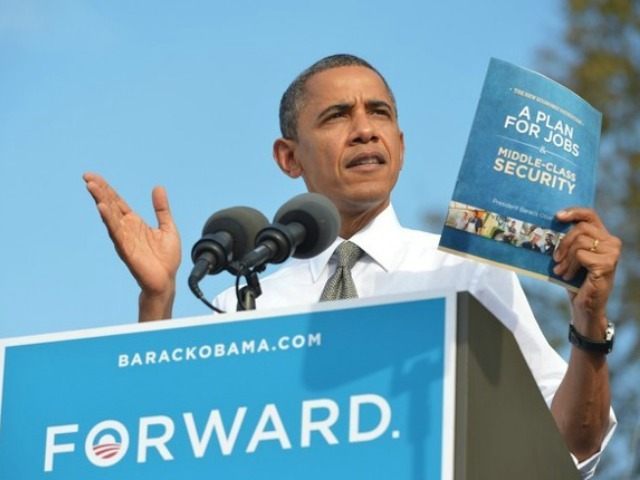The middle class in America is declining and no longer constitutes a majority under President Barack Obama, according to a Pew Research study, which found that “after more than four decades of serving as the nation’s economic majority, the American middle class is now matched in number by those in the economic tiers above and below it.”
Pew found that the “share of American adults living in middle-income households has fallen from 61% in 1971 to 50% in 2015. The share living in the upper-income tier rose from 14% to 21% over the same period. Meanwhile, the share in the lower-income tier increased from 25% to 29%.”
According to the study that was released on Wednesday, “married adults (both with and without children at home) are more likely than unmarried adults to live in upper-income households and less likely to be in lower-income households” and white and Asians “are more likely than black and Hispanic adults to be in the upper-income tier, and they are less likely to be in the lower-income tier.” But “over the longer term, black adults sustained the largest increase in income status from 1971 to 2015 and were the only major racial or ethnic group to experience a decline in their lower-income share.”
The study also found that “the rising share of immigrants in the Hispanic adult population” (29% in 1970 to 49% in 2015) is likely the reason why “Hispanic adults have slipped down the income ladder since 1971, driven by an increase from 34% to 43% in their lower-income share.” Foreign-born Hispanics were less likely to be in the middle class than U.S.-born Hispanics. The study also found that “in terms of differences by nativity, foreign-born adults are more likely than U.S.-born adults to be lower income (38% to 27% in 2015), and less likely to be upper income (16% to 22%).”
Pew defines “middle-income” Americans “as adults whose annual household income is two-thirds to double the national median, about $42,000 to $126,000 annually in 2014 dollars for a household of three. Under this definition, the middle class made up 50% of the U.S. adult population in 2015, down from 61% in 1971. Lower-income households have incomes less than 67% of the median, and upper-income households have incomes that are more than double the median”:
The income it takes to be middle income varies by household size, with smaller households requiring less to support the same lifestyle as larger households. For a three-person household, the middle-income range was about $42,000 to $126,000 annually in 2014. However, a one-person household needed only about $24,000 to $73,000 to be middle income. For a five-person household to be considered middle income, its 2014 income had to range from $54,000 to $162,000.
According to Pew, “the hollowing of the American middle class has proceeded steadily for more than four decades. Since 1971, each decade has ended with a smaller share of adults living in middle-income households than at the beginning of the decade, and no single decade stands out as having triggered or hastened the decline in the middle.” But the Great Recession and the housing crash, according to the study, especially hurt middle-income Americans, whose financial portfolios are more dependent on the value of their homes.
The study also found that mechanics, laborers, and transportation occupations were some of the job groupings with “shrinking shares of overall employment” that “lost income status since 1971.” According to the report, “manufacturing accounted for 26% of employed adults in 1971, compared with 11% in 2014. In 1971, 15% of workers in nondurable goods manufacturing and 16% of workers in durable goods manufacturing had upper-tier incomes, compared with 26% and 27% who did so in 2014, respectively.”
The study found that “beginning in the early 1990s and intensifying during the following decade, jobs increasingly have been concentrated in high-skilled and low-skilled occupations.” But politicians on both sides of the aisle have been pushing for massive increases in high-tech guest-worker visas in addition to more low-skilled immigrants that will threaten Americans across all income levels, especially those looking to stay in the middle class and enter into it.
Americans are less likely to feel like they belong to the middle class as well. A Gallup poll earlier this year found that just 51% of Americans said they are in the “middle or upper class,” down from a 61% average from 2000 to 2008. In addition, 48% said they were in the “working or lower class.”

COMMENTS
Please let us know if you're having issues with commenting.